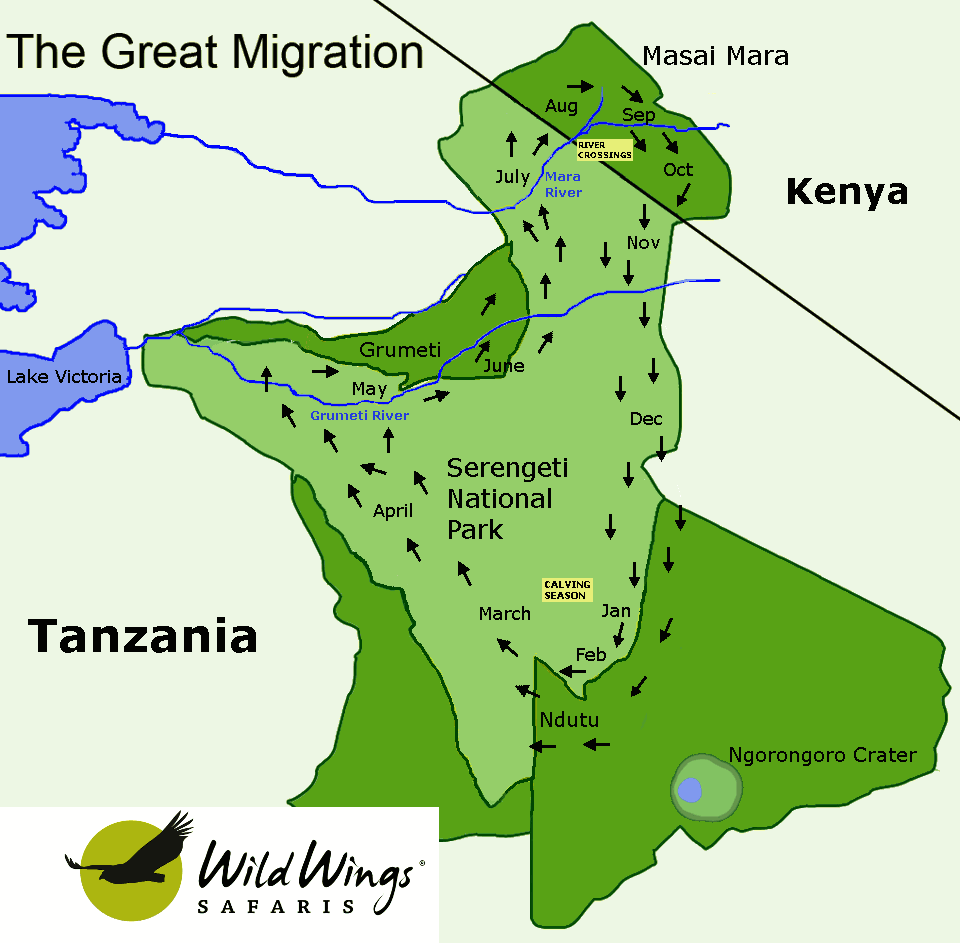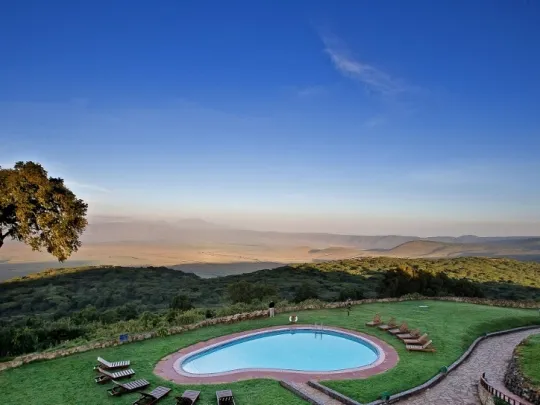When to Visit Tanzania
January to March
- Big herds of wildebeest gather in the southern plains of the Serengeti and Ndutu regions.
- Peak calving season occurs over about 2 to 3 weeks during February.
- Many predators are attracted to the area.
- Visibility is usually excellent with animals on the open plains.
- Book well in advance for this time of year if you want to visit Ndutu and the southern plains.
- January and February are reasonably dry, but March sees the start of the rainy season.

Serengeti Migration Map
April to May
- This is the low season, but is still a good time to travel
- There are fewer visitors, less crowding, less dust.
- It is the rainy season (the long rains) but it does not rain all day, every day.
- In southern Tanzania, many camps close during this time as some roads become impassable.
- Skies with thunderclouds are often dramatic and sunsets are spectacular which make breathtaking backdrops for photographs.
- Most lodges and hotels offer lower rates at this time.
- In general, the herds gather around central Serengeti and start to move towards Grumeti.
June to July
- Peak season for Tanzania. The herds of wildebeest move northwards toward Kenya.
- The Seronera region, Grumeti region and northern regions are the place to be.
- The herds cross the Grumeti river and start to move toward the Mara river in the northern Serengeti. The exact timing of their movements depend on annual rainfall patters and differ from year to year.

On Safari, Tanzania
August to October
- It is still peak safari season for both northern and southern Tanzania.
- By now, the Great Migration has reached the Maasai Mara in Kenya.
- Thousands of wildebeest make the dangerous river crossings - one of the most spectacular annual wildlife scenes you can witness. Huge crocodiles patrol the rivers waiting for the herds to cross. Many die during the crossings, but thousands more make it across safely.
- Hundreds of thousands of wildebeest roam the Maasa Mara reserve while huge herds still remain in the northern reaches of the Serengeti.
- Time and patience usually pay off for those who stay in the area at this time - further river crossings often occur but the exact time and place is impossible to predict. Sometimes the herds bunch together on the riverbank for days before they start to cross. You need a bit of luck to witness a river crossing. Kenya may be a better destination during this time if you want to see the migration and the river crossings.
- By October, the herds start moving back south again, into the Serengeti.
November to December
- The larger herds start to make their way back from the north.
- The migration continues southwards across the Serengeti toward the southern plains.
- The short rains bring the first green grass to the southern plains.
- Once more, the migration cycle begins anew.
- This is a less crowded time to visit Tanzania but a really good option for those who still want great game viewing with fewer vehicles around.
- Short, dramatic thunderstorms are possible.

Tanzania, a Photographer's Dream
All Year Round
Tanzania is good to visit at any time of the year since there is no real winter to speak of.
- Daytime temperatures generally range from 15-25°C (60-80°F) and 4-10°C (39-50°F) at night from May to October
- From November to March, the days range between 21-32°C (70-90°F) and nights between 15-23° C (59-73°F)
- At any time of the year, temperatures drop considerably in the high altitude areas like Kilimanjaro and Ngorongoro Crater. The crater rim can be surprisingly cold - bring warm clothes!
- Within the Serengeti/Ngorongoro ecosystems, there is plenty of resident game throughout the year.
- The Great Migration is undoubtedly the biggest draw card, but don't feel limited by it. The Serengeti is a fantastic year round safari destination.
- Predicting movements of the herds is often educated guesswork - every year is slightly different.
- The movement of the migratory herds do not follow a set schedule and depend largely on weather patterns, rainfall, food supply and so on.
- Southern Tanzania has many lesser-known hidden gems and is far less crowded than the northern safari circuit.
Combining Tanzania with other destinations?
Enquire now for more expert advice on the ideal time to go to get the best out of multiple destinations.
See our Tanzania Travel Guide for more information.
See our recommended tours for Tanzania.
Find out more about how the Great Migration works here.

Arusha, Tanzania's climate month by month
You may also want to look at

Ngorongoro Sopa Lodge
Situated on the eastern side of the spectacular Ngorongoro Crater, the Ngorongoro Sopa Lodge offers comfortable accommodation with breathtaking views. Watching the sun set over the crater from your private balcony or the welcoming central lodge area is an experience not to be missed. With easy access to the road down to the crater floor and its concentration of wildlife, including the Big Five, this lodge is a great base at Ngorongoro Crater.

Serengeti Sopa Lodge
With sweeping views over the vast plains of the world-renowned Serengeti, rich with wildlife, this relatively large lodge is bright and cheerful. There is resident game all year round and, if you time it right, you may even catch the Great Migration passing through, a once in a lifetime experience.

Serengeti Migration Camp
Perched on a rocky kopje near the Grumeti River in northern Serengeti, this tented camp provides a luxurious camping experience. Time it right and you'll not only get to see the abundant resident game, but you may also catch the once in a lifetime spectacle of the Great Migration passing through.




